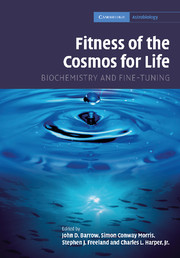Book contents
- Frontmatter
- Contents
- List of contributors
- Foreword: The improbability of life
- Preface
- Acknowledgments
- Part I The fitness of “fitness”: Henderson in context
- Part II The fitness of the cosmic environment
- Part III The fitness of the terrestrial environment
- 10 How biofriendly is the universe?
- 11 Tuning into the frequencies of life: a roar of static or a precise signal?
- 12 Life on earth: the role of proteins
- 13 Protein-based life as an emergent property of matter: the nature and biological fitness of the protein folds
- 14 Could an intelligent alien predict earth's biochemistry?
- 15 Would Venus evolve on Mars? Bioenergetic constraints, allometric trends, and the evolution of life-history invariants
- Part IV The fitness of the chemical environment
- Index
- References
11 - Tuning into the frequencies of life: a roar of static or a precise signal?
Published online by Cambridge University Press: 18 December 2009
- Frontmatter
- Contents
- List of contributors
- Foreword: The improbability of life
- Preface
- Acknowledgments
- Part I The fitness of “fitness”: Henderson in context
- Part II The fitness of the cosmic environment
- Part III The fitness of the terrestrial environment
- 10 How biofriendly is the universe?
- 11 Tuning into the frequencies of life: a roar of static or a precise signal?
- 12 Life on earth: the role of proteins
- 13 Protein-based life as an emergent property of matter: the nature and biological fitness of the protein folds
- 14 Could an intelligent alien predict earth's biochemistry?
- 15 Would Venus evolve on Mars? Bioenergetic constraints, allometric trends, and the evolution of life-history invariants
- Part IV The fitness of the chemical environment
- Index
- References
Summary
Introduction
A glance at a bacterium, and a humpback whale, will reveal not only two immensely complex organisms, but also two very different life forms. Each is, in its respective way, constrained by a whole series of physical and chemical factors. One of the most obvious aspects is the fluid environment in which they live, albeit at scales that in being separated by about eight orders of magnitude are determinative of radically different behaviors. The bacterium's world is submillimetric, and accordingly it is dominated by constraints of viscosity. Motion involves the remarkable method of flagellar propulsion (the nearest thing to a wheel in biology; see, for example, Berg, 2003). When its flagella stop beating, the bacterium ceases its movement in a distance equivalent to the diameter of a hydrogen atom. The humpback whale, by contrast, occupies a liquid environment with which we are somewhat more familiar, although our swimming ability is feeble compared with the whale's oceanic travel range of thousands of kilometers. Fully aquatic, the humpback occupies a world that to us is both alien, with its complex system of echolocation, and familiar, with its ability to communicate – which includes singing.
Despite such wide divergences, the basic point of commonality is that both bacteria and whales live in environments where the physical controls imposed by the physico-chemical properties of water – be they viscosity or acoustic transmission – predetermine what is biologically possible. To this simple example could be added many other physical and chemical constraints.
- Type
- Chapter
- Information
- Fitness of the Cosmos for LifeBiochemistry and Fine-Tuning, pp. 197 - 224Publisher: Cambridge University PressPrint publication year: 2007



